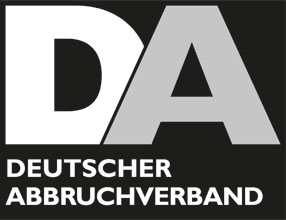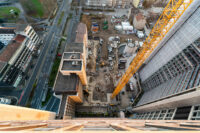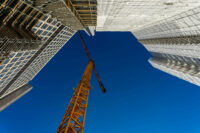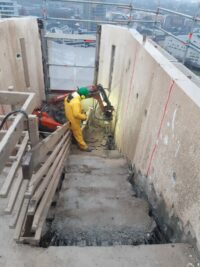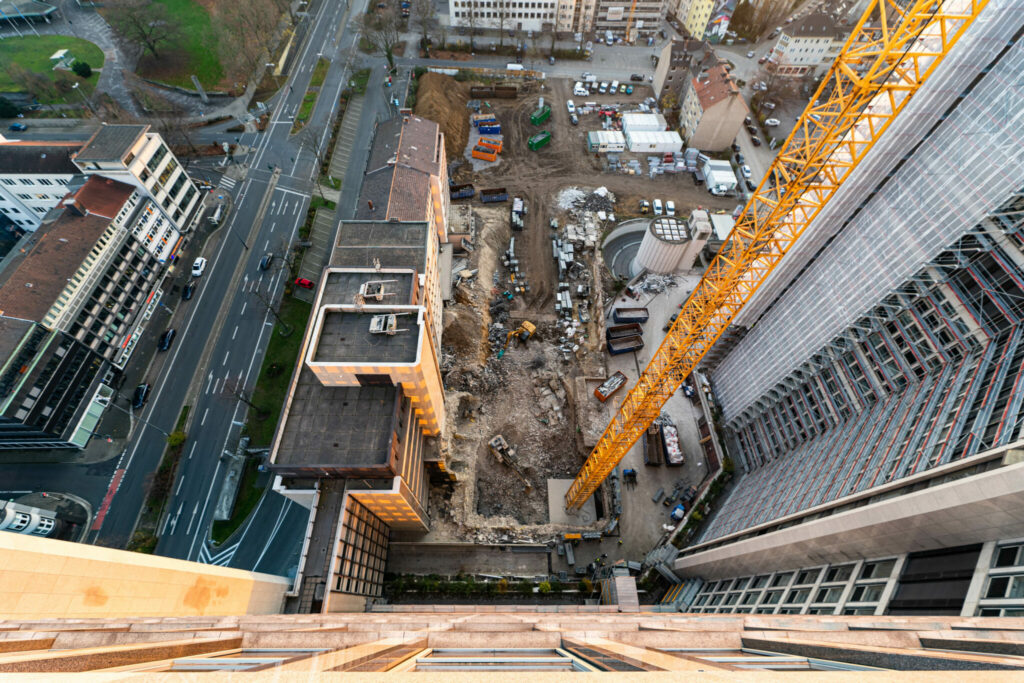
Dismantling on the former RWE site is DGNB certified

KÖLBL KRUSE aims for platinum certificate
The demolition of the former RWE high-rise building poses major challenges for BST Becker Sanierungstechnik GmbH from Oberhausen, Germany. Together with the client – KÖLBL KRUSE GmbH from Essen – the DA member company also wants to set high standards in terms of sustainability and recycling management. In a pilot project, the works are certified by the German Sustainable Building Council (DGNB). The aim is not less than platinum status.
Hardly anyone in the traditional mining town of Essen could have imagined mining resources high up instead of deep underground for decades. But this is exactly what the demolition specialists at BST set out to do when dismantling the former RWE building on Huyssenallee. As the so-called “Y-Building”, the skyscraper has shaped Essen’s skyline for four decades. Now, during the dismantling process, concrete and other building materials are being recovered here, not least due to the DGNB certification, to be used again in new applications.
Challenges of demolition
The demolition of the 18-storey high-rise building with a height of about 86 metres and the neighbouring buildings with a total of over 320,000 m3 of enclosed space already presents some challenges, even without recycling. The surrounding area is not only densely populated, the construction site is also located in the direct proximity of a tunnel of the Ruhr expressway A40, the underground car park is adjacent to a subway station. Not far away is also Essen’s main railway station. For the dismantling of the Y-building, a tower crane with a height of about 100 metres was erected to transport the dismantled concrete components to the ground. The top floors are currently being dismantled by floor using demolition robots and concrete saws. Parallel to this, the first demolition work on the buildings in the backyard using long-front excavators will start at the beginning of April.
The demolition of a small block of houses along Dreilindenstrasse, which is also part of the entire dismantling project, is already in progress. The A40 slip road will be temporarily protected by a supporting structure during the demolition phase, but in some cases it must also be completely blocked. To dismantle the pollutant-containing facade panels, the building was equipped with around 22,000 m2 of work scaffolding and provided with tear-resistant foils to prevent building materials from falling off, but also to protect the environment against dust emissions. Dismantled successively as the building is dismantled, the scaffold also serves as fall protection for the employees. In order to protect against noise, dust and vibrations, a detailed emission control concept has been developed, which includes the use of low noise machines and adequate irrigation.
A Tight schedule
The entire project is expected to be completed by early 2022, with an average of around 60 employees working on site by then. “In order to be able to carry out the dismantling work professionally within this tight schedule, we rely on the know-how of our employees and our state-of-the-art equipment. In order to be able to guarantee the high quality standards, two foremen are always on duty on the construction site in addition to the project management and the construction management,” explain the two BST managing directors Christian Becker and Michael Pfeiffer.
High requirements by DGNB
The requirements of the DGNB certificate “Building Dismantling” also cover aspects already mentioned, such as the remediation of hazardous substances, safety on the construction site or methods for reducing noise or dust emissions. However, according to construction manager Sarah Sinnwell, the focus is on the circular economy: “The focus is on the recycling of raw materials into the building cycle and supporting the recycling process in order to reduce the quantities to be disposed of as much as possible.”
The reuse of old components or furnishings also plays a role here. Here, the search for suitable customers is one of the tasks of the company. So a former kitchen was donated to Moldova. For the open-plan kitchen of the former canteen, further kitchens, washing machines, heavy-duty shelves, doors and staircase railings buyers could also be found, so that disposal in the area of clearing has already been reduced by about 20 percent.
70,000 tons of concrete are extracted
Even more impressive, according to the company, will be the percentage of concrete produced by demolition in the solid walls of the buildings. Since the beginning of March, an impressive 70,000 tons have been crushed directly on site to a grain size of between 45 and 65 millimetres and recycled 100 percent – in some cases even directly again on site when creating a new embankment. The company’s other tasks for obtaining the certificate include disposal as close as possible to the site, as well as separating the building materials by type on site and documenting this separate collection. High expenditure, which is however also worthwhile for managing director Michael Pfeiffer: “We are very proud to be able to participate in one of the first five building sites certified in such a way, therefore we do not shy away from the expenditure and all together we are also quite ambitious and would like to fulfill at least 80 percent of the DGNB requirement, which would then be platinum status.”
Information
BST Becker Sanierungstechnik GmbH
Bruchsteg 47
46147 Oberhausen
Germany
Phone: +49 208 30 20 297
info@bst-ob.de
www.bst-ob.de
